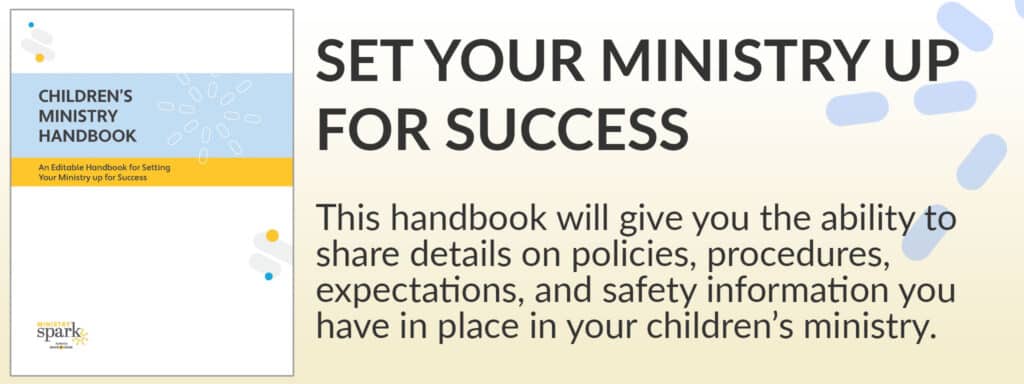I remember shopping with my daughter as we were redesigning her room. We went to store after store, just to hear “that’s the one.” She had finally found the comforter that would set the theme for her space. You see, it wasn’t just her room we were redesigning, it was her space.
It was going to be a place that she called her own. A place where she would grow physically and emotionally. Now you’re probably wondering what that has to do with kidmin, but I promise you it’s more relevant than you think.
Each week, you’re privileged to have kids walk into your children’s ministry space. The question is, “Whose space is it?” Like my daughter, the kids in your ministry are looking at your space and thinking, “Will I be comfortable here? Will this be the space where I can make friends? Will this be the space that I learn about Jesus? Is this a safe place for me?”
It’s more than just a room. Week after week, you have the opportunity to create a physical and emotional space for the kids in your ministry. Let’s make it the best we can.
3 Questions to Ask About Your Physical Children’s Ministry Spaces
A lot happens in our rooms. Kids will smile, laugh, cry, make friends, grow their faith, fall asleep (literally), and so much more. It’s more than paint and cutouts on a wall. It’s about creating a space they want to be in. One they’d be comfortable bringing their friends to. It’s about creating a space they would want to show their parents.
And before we get sidetracked by money, a big budget isn’t the only way to achieve this. Ask these three questions no matter what size space and budget you have.
1. Is It Relevant?
Let’s go ahead and make an agreement here. Let’s leave “back in my day…” back in the day. It only took a few times of my kids telling me “Dad, that’s old” for me to realize that being relevant matters.
Does your children’s ministry space look like a place where kids want to be? I’m not saying you have to deck the whole thing out, but it needs to feel like a place kids would choose to spend time.
Is the music up to date? Are the colors appealing? Do kids frown or are they excited when they come? Get feedback from kids and parents. When you’re recreating a space, let kids be part of the brainstorming. The worst thing we can do is force our kids and families to just fit into our environment. We want them to love it and know it’s theirs.
Week after week, you have the opportunity to create a physical and emotional space for the kids in your ministry.

2. Is It Fun?
Sounds simple right? Kids’ ministry needs fun. Nobody wants to be in a boring space. Just think about the most boring meeting you’ve ever been in. Now multiply that by 10. That’s how dramatic kids act when things aren’t fun.
I’m not saying you need to go out and create a circus. But would you want to be there? Would you want your kids or family to be there?
There are already so many distractions for a kid. Let’s not have the lack of fun be one of them.
3. Is It Safe?
Safety is more than just about locks, tags, and officers. Creating safe children’s ministry spaces allows kids to be themselves. Creating a safe place helps parents to have trust.
When a family walks into your space, what do they see? What do they feel? How do parents feel when they leave their kids in your space?
It doesn’t need to be Fort Knox, but you’re caring for the future generation, and that’s worth making sure your space is safe.
Emotional Children’s Ministry Spaces
It’s easy to focus on our physical space and forget that there’s an entire emotional space to the ministry we do. I remember researching schools as we prepared to move. While I was focused on the location, stats, and if it would create a great environment, I imagine my children were asking some of these questions.
Will I be accepted? Will I belong? Will I be loved?
There’s beauty when a kid has the opportunity to be themselves in our spaces. So as we evaluate our spaces, we need to ask some emotional questions.
Help children know they are there for a reason. That reason is to encounter people who love Jesus and love them too.
1. Will I Be Accepted?
Acceptance is deeper than just getting in the door. Kids, just like us, have a desire to feel accepted, and our space can help foster that. It starts with our websites, promotional material, guest experiences, classrooms, and so much more.
You see, not only do you have to help each child feel accepted, you have to help their parents know their child will be accepted. It takes time and consistency to build trust. The idea of loving your neighbor as yourself means accepting them for who they are. Helping them know they are there for a reason.
That reason is to encounter people who love Jesus and love them too. I bet just hearing that, you would feel accepted. Let’s offer that and more to our children and families.
2. Will I Belong?
I remember my grandmother coming to my little league basketball game and saying, “Drae, you belong here.” I never understood that until I started working in kids’ ministry. When our space allows kids to make friends, see themselves, and not just feel like another number, life change can happen.
Kids won’t just be coming to a service you created, they’ll be part of something much greater. When kids belong, it breaks down mental and emotional barriers and allows them to do what we truly hope they will do: fall in love with Jesus.
3. Will I Be Loved?
Kids in your ministry are most likely hearing that God loves them so much, but are they feeling that? We get to help kids experience God’s love. A love that’s unconditional. A love that’s worth sharing.
In your space, do they see these affirmations? Do they hear these affirmations? Do they feel these affirmations?
It’s so important for the kids to feel this love, and it starts with us as leaders and volunteers. Our overflow of God’s love will make all the difference for our kids. So let’s fill up and change the lives of our kiddos.

Impact of Your Children’s Ministry Spaces
So, what do we do now? I was listening to a podcast, and the host mentioned this idea of getting 1% better each day. Not overdoing it, but simply setting a goal to just get better.
That’s what we have to do.
Maybe your children’s ministry space needs some updating. Maybe your experience team needs to assess the emotional needs of the kids you serve. Ask yourself, “What’s at stake if we don’t look at our physical and emotional space?”
The next generation of kids, leaders, and volunteers is at stake. Our ministries need to be places where all kids and families can come.
So let’s get better. Even if it’s 1% a day.
More Articles You May Like
- Innovative Children’s Ministry Room Designs that Will Inspire You
- 6 Easy Ways to Renovate Your Children’s Ministry Space
- How to Make Space for Worship Response in Your Kidmin
- Sensory Spaces for Kids in the COVID-19 Church
- Make Space for The Holy Spirit to Teach Kids
- Making Space for the Holy Spirit in Your Ministry
- Making Room for Wonder: The Benefits of an Organized Space
- Wonder-filled Conversation & Making Space for God in Your Kidmin
- How to Create a Sensory Room for Students with Special Needs












